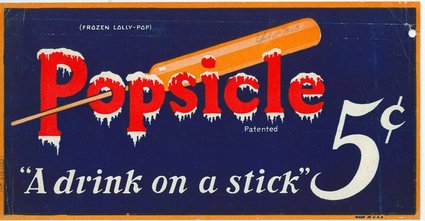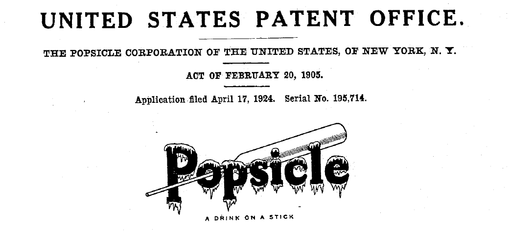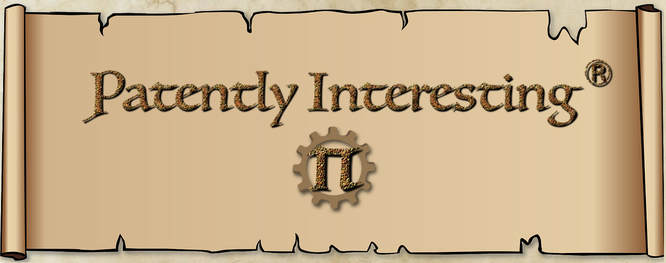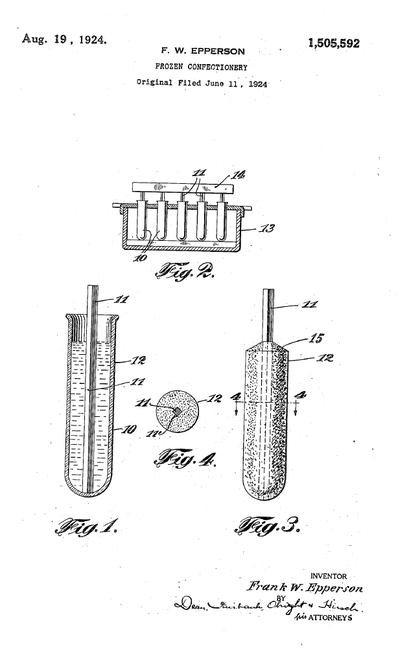 Early Advertisement for Popsicles
Early Advertisement for Popsicles
On August 19 of the year 1924, U.S. Patent No.: 1,505,592 issued to Frank W. Epperson for "Frozen Confectionery". The invention for which Epperson received his patent had allegedly been made more than 19 years earlier when Epperson was only 11 years old. As the story goes, after a hard day of play, Epperson decided to make himself a drink using water and a sugary soda powder, which was popular at the time. Epperson used a wooden stick to mix the concoction in a container. Somehow, Epperson got distracted and failed to drink his concoction, leaving it outside on the porch of his family's house overnight. It was a very cold night and when Epperson went outside to retrieve his drink, he discovered it had frozen, with the stick protruding from the frozen surface. Not letting it go to waste, Epperson devoured his tasty creation, which is now known as the "Popsicle".
Considering that Epperson's invention supposedly took place in San Francisco and that the temperature in San Francisco only very rarely goes below freezing, it seems doubtful that the story of Epperson's invention is completely accurate. Nonetheless, it is a good story and one that picks up in the early 1920's when Epperson was an adult. He started selling his frozen creation in his neighborhood, calling it the "Epsicle", which was a portmanteau of his last name and "icicle". Epperson later changed the name to "Popsicle" at the behest of his children, who referred to it as "Pop's Sicle".
In order to protect his invention, Epperson filed his first patent application for the Popsicle on March 5 of 1923. In that same year, Epperson joined together with employees of the Loew Movie Company to form the Popsicle Company. The newly-formed company introduced the Popsicle to concessionaires at amusement parks and beaches, where it became wildly successful.
In 1924, a new Popsicle Company was formed, which purchased the interests of the Loew employees. On June 11 and July 19 of that year, Epperson filed two more patent applications for the Popsicle, respectively, both of which claimed priority from his first application. However, only the '592 patent would issue from the three patent applications he filed.
The '592 patent reveals that the early Popsicles were different from the ones that are produced today. In accordance with the '592 patent, syrup was charged to a group of test tubes and wooden sticks with polygonal cross-sections were inserted into the test tubes, respectively, with the ends of the sticks pressed into the test tube bottoms. The syrup ws comprised mostly of water, as well as flavoring matter and sugar. The wood of the sticks was porous and tasteless, such as bass, birch or poplar. Importantly, the test tubes were quickly frozen, without agitating the syrup inside. This processing feature created a homogenous frozen mass of hard snowy consistency, as opposed to the more creamy consistency of today's Popsicles. The snowy consistency, in turn, allowed the Popsicle to "be consumed by sucking thereon in which operation, the chilled more or less concentrated flavoring consituent will be drawn into the mouth as a refreshing drink derived from the solid on the stick, leaving a white and colorless mass of ice or snow....."
Considering that Epperson's invention supposedly took place in San Francisco and that the temperature in San Francisco only very rarely goes below freezing, it seems doubtful that the story of Epperson's invention is completely accurate. Nonetheless, it is a good story and one that picks up in the early 1920's when Epperson was an adult. He started selling his frozen creation in his neighborhood, calling it the "Epsicle", which was a portmanteau of his last name and "icicle". Epperson later changed the name to "Popsicle" at the behest of his children, who referred to it as "Pop's Sicle".
In order to protect his invention, Epperson filed his first patent application for the Popsicle on March 5 of 1923. In that same year, Epperson joined together with employees of the Loew Movie Company to form the Popsicle Company. The newly-formed company introduced the Popsicle to concessionaires at amusement parks and beaches, where it became wildly successful.
In 1924, a new Popsicle Company was formed, which purchased the interests of the Loew employees. On June 11 and July 19 of that year, Epperson filed two more patent applications for the Popsicle, respectively, both of which claimed priority from his first application. However, only the '592 patent would issue from the three patent applications he filed.
The '592 patent reveals that the early Popsicles were different from the ones that are produced today. In accordance with the '592 patent, syrup was charged to a group of test tubes and wooden sticks with polygonal cross-sections were inserted into the test tubes, respectively, with the ends of the sticks pressed into the test tube bottoms. The syrup ws comprised mostly of water, as well as flavoring matter and sugar. The wood of the sticks was porous and tasteless, such as bass, birch or poplar. Importantly, the test tubes were quickly frozen, without agitating the syrup inside. This processing feature created a homogenous frozen mass of hard snowy consistency, as opposed to the more creamy consistency of today's Popsicles. The snowy consistency, in turn, allowed the Popsicle to "be consumed by sucking thereon in which operation, the chilled more or less concentrated flavoring consituent will be drawn into the mouth as a refreshing drink derived from the solid on the stick, leaving a white and colorless mass of ice or snow....."

The "drink" aspect of the early Popsicles was marketed heavily, starting in 1924. Popsicles were advertised in trade journals and other publications as being "A Drink on a Stick". In addition, the Popsicle Company obtained a trademark registration for a trademark containing "Popsicle" and the byline "A drink on a Stick" (see to the right). Interestingly, the byline was deleted in an amendment made to the registration in 1960.
Beginning in 1924, the Popsicle Company began a campaign to enforce the '592 patent against competitors who had entered the market for frozen confections on a stick. The patent enforcement campaign was successful and helped eliminate many competitors. However, the Popsicle Company received a dose of its own medicine in 1925 when it was sued by the Good Humor Corporation of America for infringing their U.S. Patent No.: 1,470,524 to Burt. The Burt '524 patent issued from an application that predated the filing of Epperson's first patent application. While mainly directed to ice cream on a stick, the Burt '524 patent was broad enough to cover the Popsicle. The lawsuit between the Popsicle Company and the Good Humor Corporation was eventually settled, with the two companies essentially dividing up the market for frozen confections on a stick. The Good Humor Corporation granted the Popsicle Company a license under its patents to make and sell frozen confections comprised of "a mass of flavored syrup, water ice or sherbet frozen on a stick" and agreed not to itself make or sell such frozen confections. The Good Humor Corporation would instead focus on selling ice cream on a stick.
Beginning in 1924, the Popsicle Company began a campaign to enforce the '592 patent against competitors who had entered the market for frozen confections on a stick. The patent enforcement campaign was successful and helped eliminate many competitors. However, the Popsicle Company received a dose of its own medicine in 1925 when it was sued by the Good Humor Corporation of America for infringing their U.S. Patent No.: 1,470,524 to Burt. The Burt '524 patent issued from an application that predated the filing of Epperson's first patent application. While mainly directed to ice cream on a stick, the Burt '524 patent was broad enough to cover the Popsicle. The lawsuit between the Popsicle Company and the Good Humor Corporation was eventually settled, with the two companies essentially dividing up the market for frozen confections on a stick. The Good Humor Corporation granted the Popsicle Company a license under its patents to make and sell frozen confections comprised of "a mass of flavored syrup, water ice or sherbet frozen on a stick" and agreed not to itself make or sell such frozen confections. The Good Humor Corporation would instead focus on selling ice cream on a stick.


